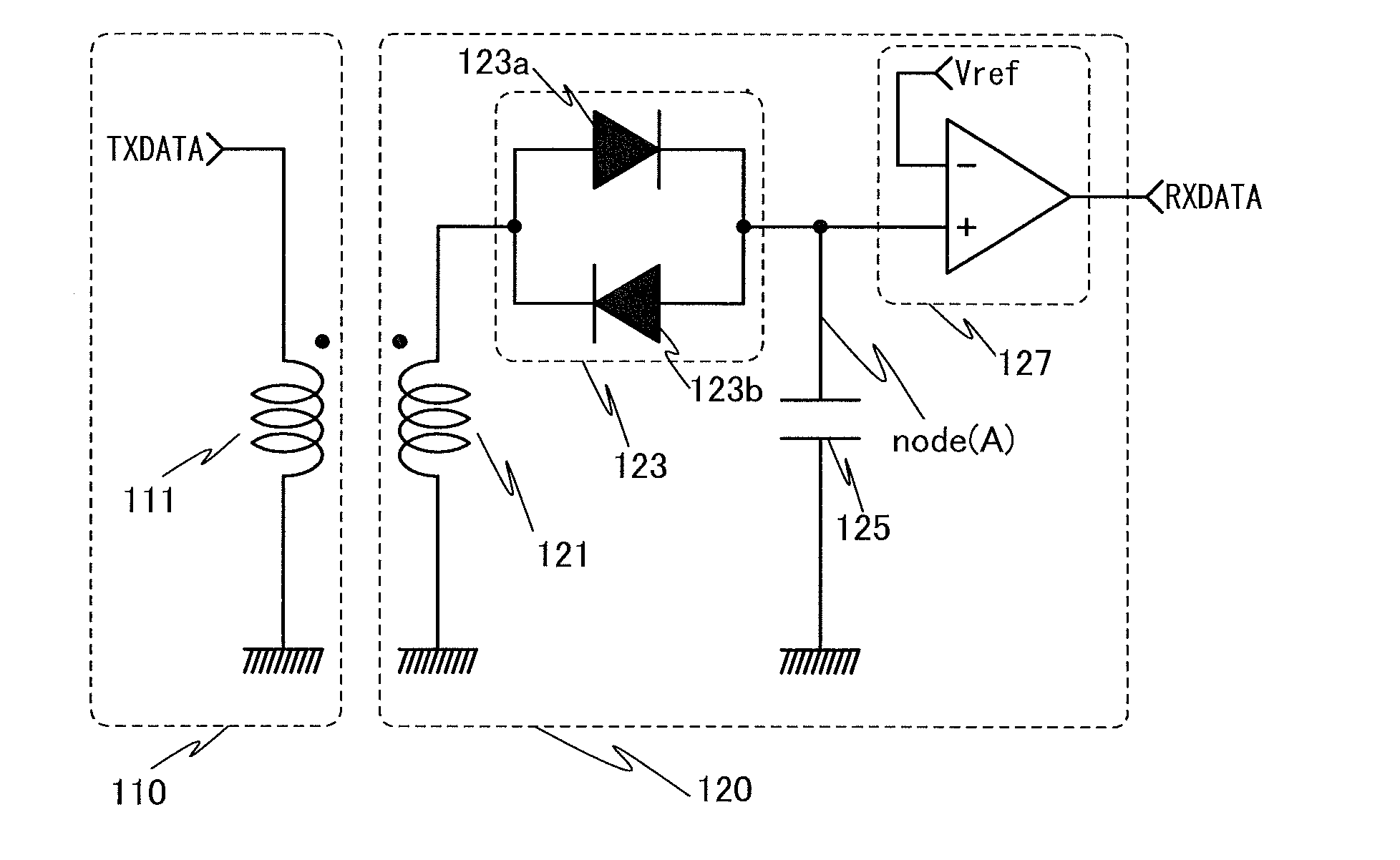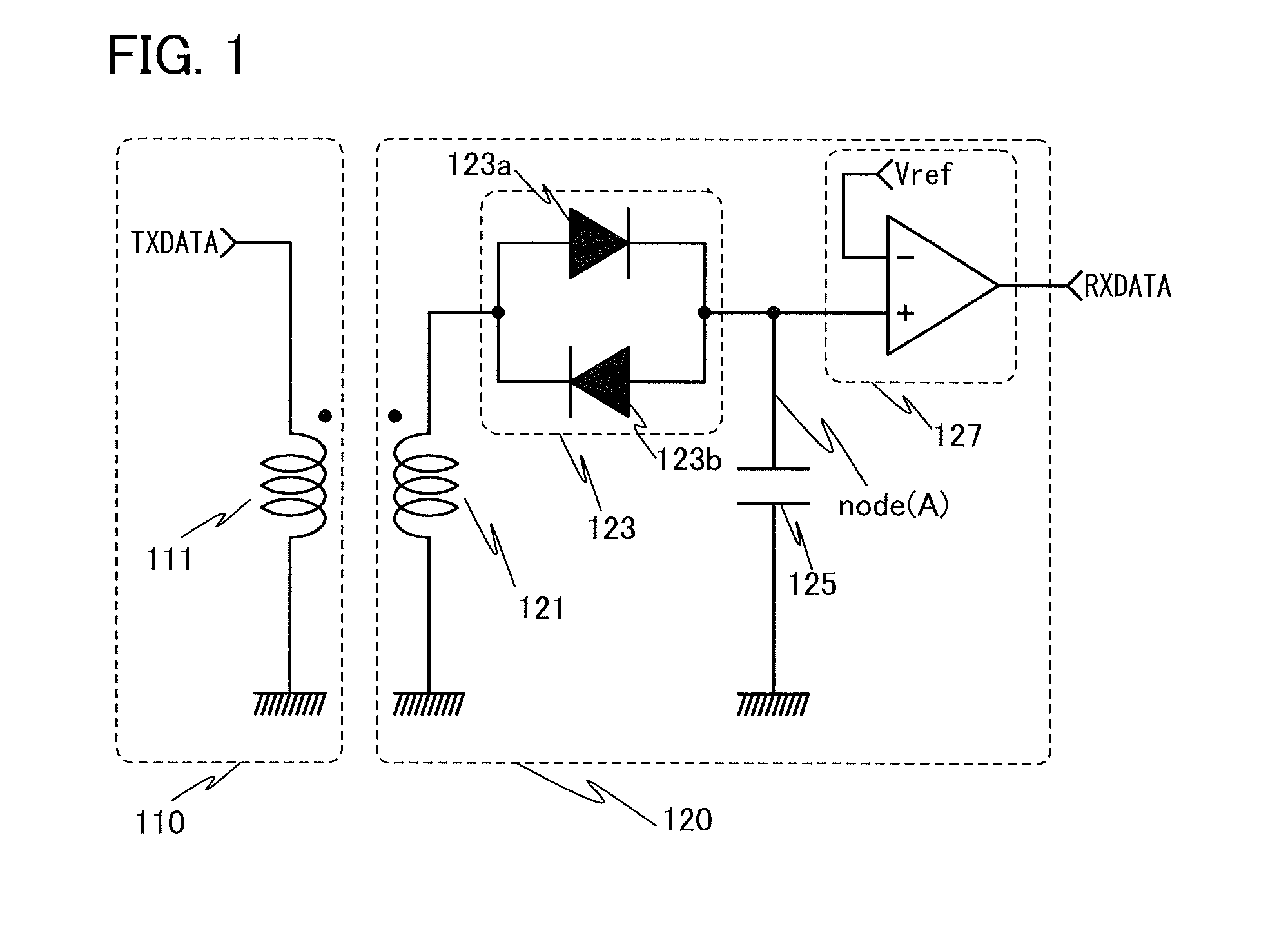Receiving circuit, LSI chip, and storage medium
a technology of receiving circuit and storage medium, applied in the field of receiving circuit, can solve problems such as difficulty in reducing circuit scale and circuit siz
- Summary
- Abstract
- Description
- Claims
- Application Information
AI Technical Summary
Benefits of technology
Problems solved by technology
Method used
Image
Examples
embodiment 1
[0049]In this embodiment, a receiving circuit in one embodiment of the present invention is described with reference to FIG. 1 and FIGS. 2A to 2D. FIG. 1 is a circuit diagram illustrating a structure example of part of a transmitting circuit and a receiving circuit in this embodiment. FIGS. 2A to 2D are examples of timing charts at the time when signals are transmitted and received.
[0050]First, circuit structures of a transmitting circuit 110 and a receiving circuit 120 in this embodiment are described with reference to FIG. 1.
[0051]The transmitting circuit 110 has a function of transmitting a transmitting signal with the use of a coil. The transmitting circuit 110 in this embodiment includes a coil 111. One terminal of the coil 111 is connected to a ground potential line, and a transmitting signal TXDATA is input to the other terminal of the coil 111. Note that although the one terminal of the coil 111 is grounded in this embodiment, this embodiment is not limited to this structure...
embodiment 2
[0074]In this embodiment, a structure where a transistor whose leakage current is markedly reduced is used as the diode element in the receiving circuit in Embodiment 1 is described with reference to FIG. 3, FIG. 4, and FIGS. 5A to 5D.
[0075]FIG. 3 illustrates structure examples of the transmitting circuit 110 and a receiving circuit 220 in this embodiment.
[0076]The transmitting circuit 110 has the same structure as that in Embodiment 1. The receiving circuit 220 has a structure which is similar to that of the receiving circuit 120 in Embodiment 1 except that the diode element 123a and the diode element 123b in the parallel circuit 123 are replaced with a transistor 223a and a transistor 223b, respectively. In other words, a coil 221, a capacitor 225, and a comparison circuit 227 are similar to the coil 121, the capacitor 125, and the comparison circuit 227 in the receiving circuit 120, respectively.
[0077]A parallel circuit 223 includes the transistor 223a and the transistor 223b. A ...
embodiment 3
[0103]In this embodiment, an example of an LSI chip including a receiving circuit in one embodiment of the present invention is described with reference to FIG. 6.
[0104]FIG. 6 is a schematic diagram illustrating the structures of three LSI chips which are stacked and signal transmission and reception in the three LSI chips. LSI chips 301 to 303 illustrated in FIG. 6 each include a plurality of receiving circuits and a plurality of transmitting circuits. Arrows in FIG. 6 show the directions of signals transmitted from the transmitting circuit to the receiving circuit.
[0105]Signals are transmitted and received between a set of transmitting and receiving circuits in each LSI chip. Thus, in the case where the LSI chips are stacked, it is preferable that coils of the set of transmitting and receiving circuits substantially overlap with each other because a coupling factor between the coils can be increased. The size and shape of the coils of the transmitting and receiving circuits may be...
PUM
 Login to View More
Login to View More Abstract
Description
Claims
Application Information
 Login to View More
Login to View More - R&D
- Intellectual Property
- Life Sciences
- Materials
- Tech Scout
- Unparalleled Data Quality
- Higher Quality Content
- 60% Fewer Hallucinations
Browse by: Latest US Patents, China's latest patents, Technical Efficacy Thesaurus, Application Domain, Technology Topic, Popular Technical Reports.
© 2025 PatSnap. All rights reserved.Legal|Privacy policy|Modern Slavery Act Transparency Statement|Sitemap|About US| Contact US: help@patsnap.com



